David Weiden at VCFA
Program Awesomeness
 One of the best things about The Writing & Publishing program here at VCFA is the amazing visiting writers that come to speak and to teach modules. David Heska Wanbli Weiden is just such a person.
One of the best things about The Writing & Publishing program here at VCFA is the amazing visiting writers that come to speak and to teach modules. David Heska Wanbli Weiden is just such a person.
Although he started his MFA right here at VCFA, he completed it at the Institute of American Indian Arts. He also holds a law degree and a PhD. He’s a Tin House Scholar, a MacDowell Fellow, and a PEN/America Writing for Justice Fellow.
David is the author of Spotted Tale, a children’s book that tells the story of the Lakota leader of the same name. This book was awarded the 2020 Spur Awa rd by the Western Writers of America. He’s been published in the New York Times, Shenandoah, Yellow Medicine Review, Transmotion, Criminal Class Review, Tribal College Journal and many more.
rd by the Western Writers of America. He’s been published in the New York Times, Shenandoah, Yellow Medicine Review, Transmotion, Criminal Class Review, Tribal College Journal and many more.
David’s known mostly for writing crime fiction, so it makes sense that the module he taught was called “Techniques in Genre Literature.” The overarching theme of the class was that the borders between genre and literary fiction are fading, and that many genre techniques can be used to make any writing better. As an example, he taught us an outlining technique that comes from screenwriting. To say it’s the best outlining technique I’ve learned would be an understatement. It is, in fact, the only outlining technique I’ve been taught in my six years as a Creative Writing major. (I thought that would’ve come in my first creative writing class, but no.) He also taught techniques such as “varying your beginnings throughout your novel”, “ending a chapter on a cliffhanger, but use cliffhangers sparingly”, and “the best villains are a dark mirror of the protagonist.” These are techniques that work!
Winter Counts
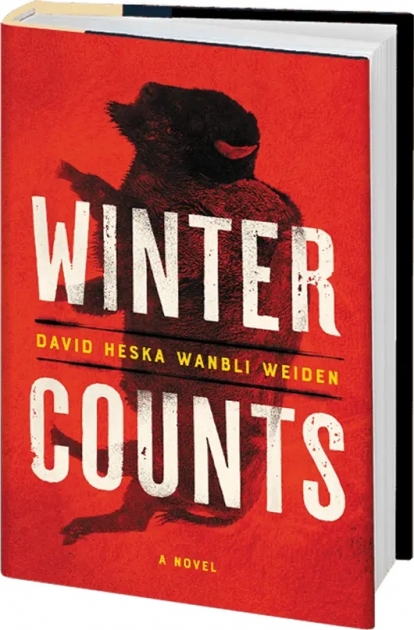 Weiden’s debut novel Winter Counts dropped in late August and is a New York Times Book Review’s Editor’s choice. Publisher’s Weekly has named it one of the Best Books of 2020. It’s gotten rave reviews from the New York Times, Publishers Weekly, The Washington Post, the Los Angeles Times, The Denver Post, USA Today, The San Francisco Chronicle, Air Mail, Crime Time, Mystery Scene, the South Florida Sun Sentinel, among others. During our craft module with David it was announced that Winter Counts is the BuzzFeed Book Club’s November pick.
Weiden’s debut novel Winter Counts dropped in late August and is a New York Times Book Review’s Editor’s choice. Publisher’s Weekly has named it one of the Best Books of 2020. It’s gotten rave reviews from the New York Times, Publishers Weekly, The Washington Post, the Los Angeles Times, The Denver Post, USA Today, The San Francisco Chronicle, Air Mail, Crime Time, Mystery Scene, the South Florida Sun Sentinel, among others. During our craft module with David it was announced that Winter Counts is the BuzzFeed Book Club’s November pick.
Plot Summary
In the opening scene Virgil Wounded Horse lays in wait for a teacher, Guv Yellowhawk, from the reservation school. When Yellowhawk, emerges from the local tavern, Virgil pounces and pounds, leaving the teacher bloody and bruised, with several broken bones. This might lead us to believe that Virgil is the villain and Yellowhawk a poor hapless victim. We’d be wrong. Yellowhawk has raped one of his students, a 9 year-old girl.
Virgil is the reservation’s enforcer, and he has waived his fee for this job.
Soon Virgil is offered another job that he’s not sure he wants to take. Heroin has been showing up on the Rez, and people are dying. Tribal Councilman, Ben Short Bear, wants Virgil to go after a member of the tribe he suspects of bringing in the drugs. The suspect turns out to be Rick Crow, Virgil’s nemesis from high school. Crow was a bully, a full blood who never let Virgil forget he was Iyeska, a half breed. While it would be satisfying for Virgil to bring Crow to justice–and the money is great–something just doesn’t feel right, so he turns down the job.
Then Virgil’s nephew overdoses on heroin, causing him to change his mind.
Winter Counts has what it takes to keep mystery and crime fiction lovers happy: twists and turns, dead-ends, the reddest of red herrings and an ending that will have readers slapping their foreheads, while still leaving them satisfied.
But Winter Counts is more than a crime novel.
This is a story about identity and belonging and finding one’s way and place in the world. The book shows Rez life without any of the usual overblown stereotypes. Heska Wanbli Weiden knows this world intimately. As an enrolled member of the Sicangu Lakota tribe, it’s the world he grew up in, the Rosebud Indian Reservation of South Dakota.
On NDN-ness
I ate this novel up. I am enrolled Delaware of Oklahoma, who’s never even been on a reservation. My tribe doesn’t live on one, and, frankly, I was raised in Los Angeles. I never met an NDN who wasn’t part of my immediate family until my mid-twenties. To read about life among a tribe was fascinating to me, especially without stereotypes.
There was so much I could relate to, from the music, (early 80s punk rock to 90s metal)(and how much did I love the pun of including Siouxsie and the Banshees in this list? Especially when we readers learn that Sioux is not an indigenous name but is what French trappers called these tribal people during the Westward Expansion. And that it means “snake.”) to the way white people see us natives; to the way we are told to speak about our own “Indian-ness.” (“I believe they like to be called Native American,” says the white, dreadlocked doctor at the pot-shop to Virgil and his girlfriend Marie.) (This had me cackling in my dorm room. That exact thing has been said to me, and just about every NDN I know!)
But then, of course, the novel told of aspects of being indigenous that I know very little about. The spirituality, elders with advice, going to the spirits to gain guidance and direction. And, just plain old life on the Rez, which tends towards poverty and despair. This novel is gritty, and real, with the plight of poverty and crime as stark and powerfully portrayed as the traditions and spirituality. Winter Counts is about reconciling past with present and paving the way for the future.
I highly recommend Winter Counts. I also recommend taking a class or workshop with David at your first opportunity.Running sneakers | Nike Shoes
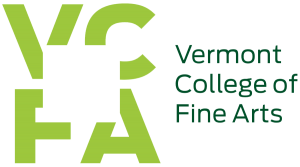
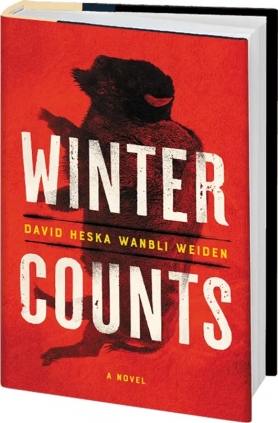
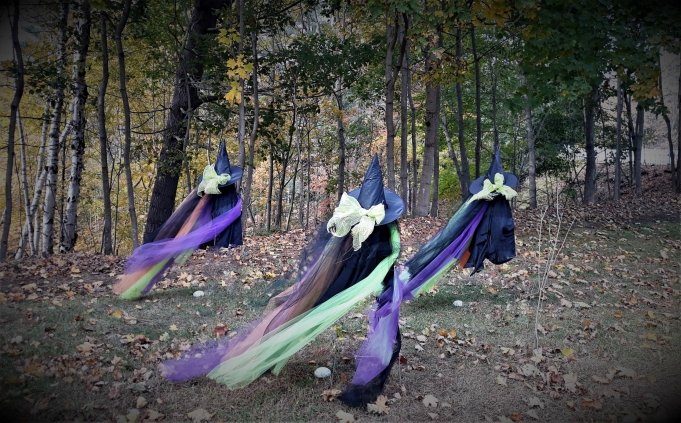
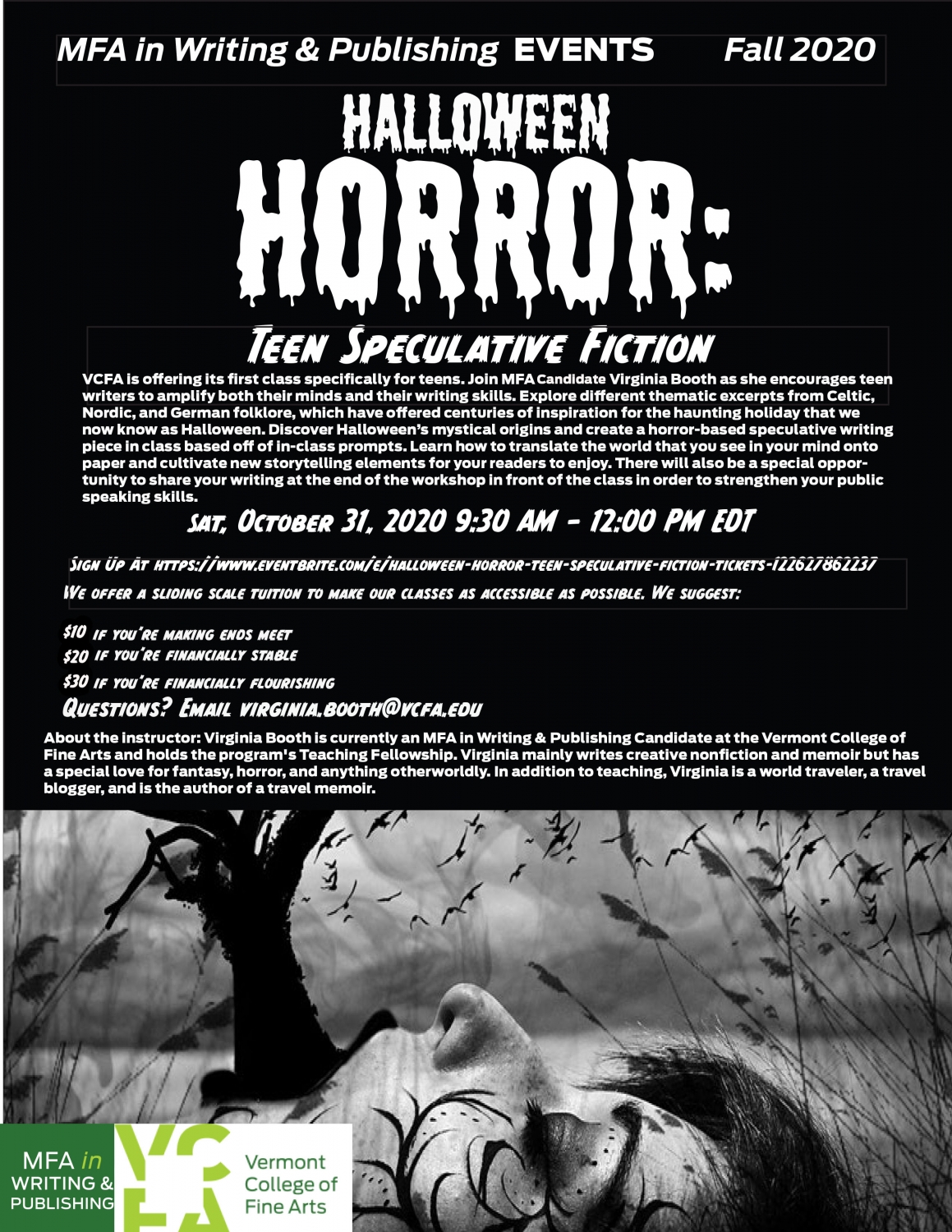

 The evening was led by James, the author of the bestselling novel The Kept, a finalist for the New England Book Award. I know I always rave about our teachers here at VCFA, but I must sing James’s praises as well. We’ve just finished his three-week class on structure, and I feel like my writing toolbox is fuller than it has ever been. Hearing his take on rising action and learning about Inner Story/Outer Story will serve me well in my future writing career. If you ever get a chance to take a class or workshop taught by James—whether here at VCFA or elsewhere—take the class. I promise you it will be worth it.
The evening was led by James, the author of the bestselling novel The Kept, a finalist for the New England Book Award. I know I always rave about our teachers here at VCFA, but I must sing James’s praises as well. We’ve just finished his three-week class on structure, and I feel like my writing toolbox is fuller than it has ever been. Hearing his take on rising action and learning about Inner Story/Outer Story will serve me well in my future writing career. If you ever get a chance to take a class or workshop taught by James—whether here at VCFA or elsewhere—take the class. I promise you it will be worth it.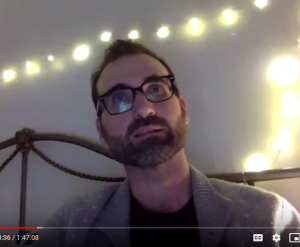 seminar and various modules. His poetry collection Mad River was published in 2017, and his chapbook 20,000 Pigeons was published in 2014. His cross-genre work has appeared in The New England Review, Ploughshares, The Rumpus, and Best American Short Stories of 2015. He is a co-founder and co-editor of Waxwing.
seminar and various modules. His poetry collection Mad River was published in 2017, and his chapbook 20,000 Pigeons was published in 2014. His cross-genre work has appeared in The New England Review, Ploughshares, The Rumpus, and Best American Short Stories of 2015. He is a co-founder and co-editor of Waxwing.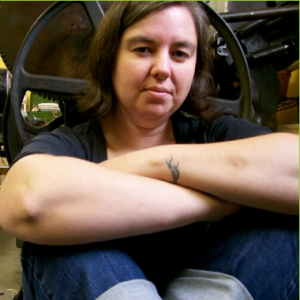 . Kelly is described on the VCFA website as a poet who “walked into a printshop and never looked back.” As visiting faculty, she teaches letterpress printing. She runs May Day Studios right here in Montpelier. Before falling for the smell of ink and paper, Kelly got her MFA in Creative Writing at California College of the Arts. (Truth be told, that’s where she succumbed to her love of letterpress.) She read us poetry from back in the day and beyond.
. Kelly is described on the VCFA website as a poet who “walked into a printshop and never looked back.” As visiting faculty, she teaches letterpress printing. She runs May Day Studios right here in Montpelier. Before falling for the smell of ink and paper, Kelly got her MFA in Creative Writing at California College of the Arts. (Truth be told, that’s where she succumbed to her love of letterpress.) She read us poetry from back in the day and beyond.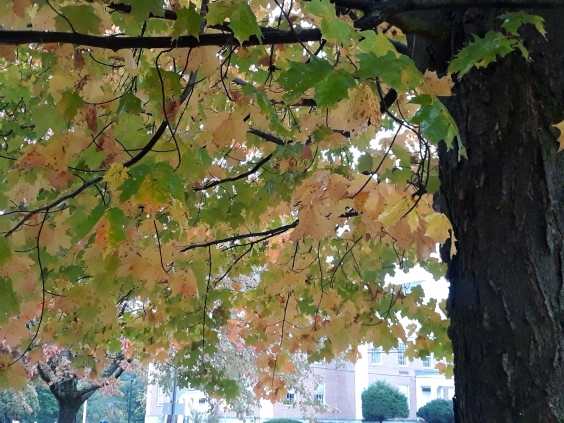
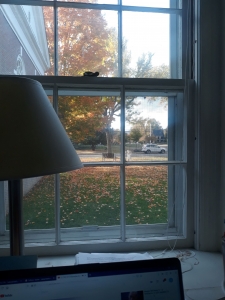 a New England Autumn, with oranges and reds mixing with green in the trees and on the grass. I think back to last year at this time, as I was just entering my second month in Vermont. Everyone warned me that we probably wouldn’t get much of a show, leaf wise, since the weather had been so “mild” for the season. When I say mild, I mean that it was 71 degrees with about a million percent humidity—or maybe it just felt like a million percent to a Californian used to dry weather. No. Even the students from the South were affectionately calling the Glover dorms “sauna.” We joked about having a luau, wearing Hawaiian shirts, and drinking cocktails decked with bits of pineapple.
a New England Autumn, with oranges and reds mixing with green in the trees and on the grass. I think back to last year at this time, as I was just entering my second month in Vermont. Everyone warned me that we probably wouldn’t get much of a show, leaf wise, since the weather had been so “mild” for the season. When I say mild, I mean that it was 71 degrees with about a million percent humidity—or maybe it just felt like a million percent to a Californian used to dry weather. No. Even the students from the South were affectionately calling the Glover dorms “sauna.” We joked about having a luau, wearing Hawaiian shirts, and drinking cocktails decked with bits of pineapple.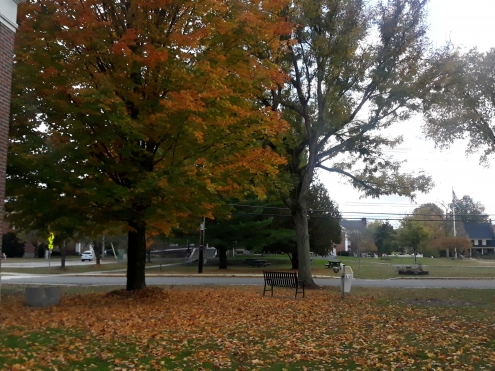
 Rita read to us from her memoir about how women keep their cool against social, sexual, and economic pressure. In a chapter titled “Cool As Kin,” Rita tells us about her family members who inspired her to be a writer and a creative. “From my great uncle I first learned about curiosity and what it meant to see the world through the eyes of an artist. His paintings were inspired by the idea of nature in meditation.”
Rita read to us from her memoir about how women keep their cool against social, sexual, and economic pressure. In a chapter titled “Cool As Kin,” Rita tells us about her family members who inspired her to be a writer and a creative. “From my great uncle I first learned about curiosity and what it meant to see the world through the eyes of an artist. His paintings were inspired by the idea of nature in meditation.”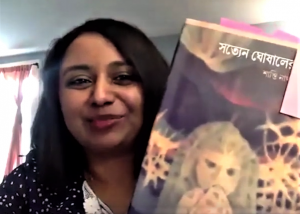
 Rita’s writing is as lush and beautiful as her uncle’s painting, with prose that reads like poetry, sounding at times like a waterfall skipping over stones. You can’t help but follow her story as it flows along. There is an especially evocative section as she describes a shadowbox tableau in her uncle’s house that shows a depiction of village life in ancient China. You can hear it from 00:12:17 to 00:14:10 on the video.
Rita’s writing is as lush and beautiful as her uncle’s painting, with prose that reads like poetry, sounding at times like a waterfall skipping over stones. You can’t help but follow her story as it flows along. There is an especially evocative section as she describes a shadowbox tableau in her uncle’s house that shows a depiction of village life in ancient China. You can hear it from 00:12:17 to 00:14:10 on the video.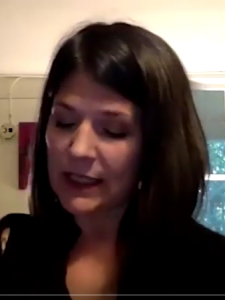 founder of the magazine Waxwing, and, of course, teaches here at VCFA. Erin told us that her tactic for picking what to read was to go with the piece that scared her the most to share, and she then read the first half of the first chapter of her novel in progress The Keener.
founder of the magazine Waxwing, and, of course, teaches here at VCFA. Erin told us that her tactic for picking what to read was to go with the piece that scared her the most to share, and she then read the first half of the first chapter of her novel in progress The Keener.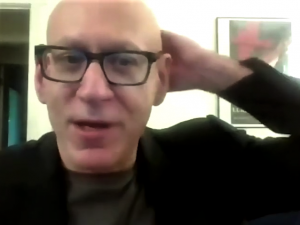 David read to us from his soon-to-be-published book The Very Last Interview, a compilation of some 2,700 questions that he’s been asked in interviews over the past 40 or so years. Not his answers, mind you, of which he said he has no interest, but the questions. He’s “fascinated by the aggressiveness” of these questions. He’s not kidding. These are some of the rudest, most pompous and arrogant questions to ever escape the mind, mouth, or pen of an interviewer. David views these as humorous. I can see the humor in them, BUT…if they were asked of me I’m sure I would’ve had to spend some time as a puddle-of-sad on the floor, or on a mountaintop flinging lightening bolts before I ever thought of laughing. Kudos to David for having a thicker skin!
David read to us from his soon-to-be-published book The Very Last Interview, a compilation of some 2,700 questions that he’s been asked in interviews over the past 40 or so years. Not his answers, mind you, of which he said he has no interest, but the questions. He’s “fascinated by the aggressiveness” of these questions. He’s not kidding. These are some of the rudest, most pompous and arrogant questions to ever escape the mind, mouth, or pen of an interviewer. David views these as humorous. I can see the humor in them, BUT…if they were asked of me I’m sure I would’ve had to spend some time as a puddle-of-sad on the floor, or on a mountaintop flinging lightening bolts before I ever thought of laughing. Kudos to David for having a thicker skin!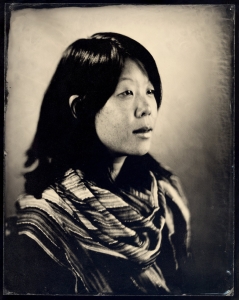 We welcome
We welcome 
 The snow keeps falling, followed by rain, then sun, then snow again. The winter walks are as delightful as the summer walks, and the views may just be more inspiring. It’s wonderful as a writer to be in a place as varied and beautiful as Montpelier. Whenever I
The snow keeps falling, followed by rain, then sun, then snow again. The winter walks are as delightful as the summer walks, and the views may just be more inspiring. It’s wonderful as a writer to be in a place as varied and beautiful as Montpelier. Whenever I get stuck on something, stumble over a bit of writer’s block, I amble outside for some fresh air and exercise to get my thoughts flowing again. We’re lucky to be here!
get stuck on something, stumble over a bit of writer’s block, I amble outside for some fresh air and exercise to get my thoughts flowing again. We’re lucky to be here!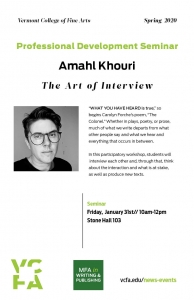 This Friday’s Professional Development Seminar is being led by playwright Amahl Khouri
This Friday’s Professional Development Seminar is being led by playwright Amahl Khouri 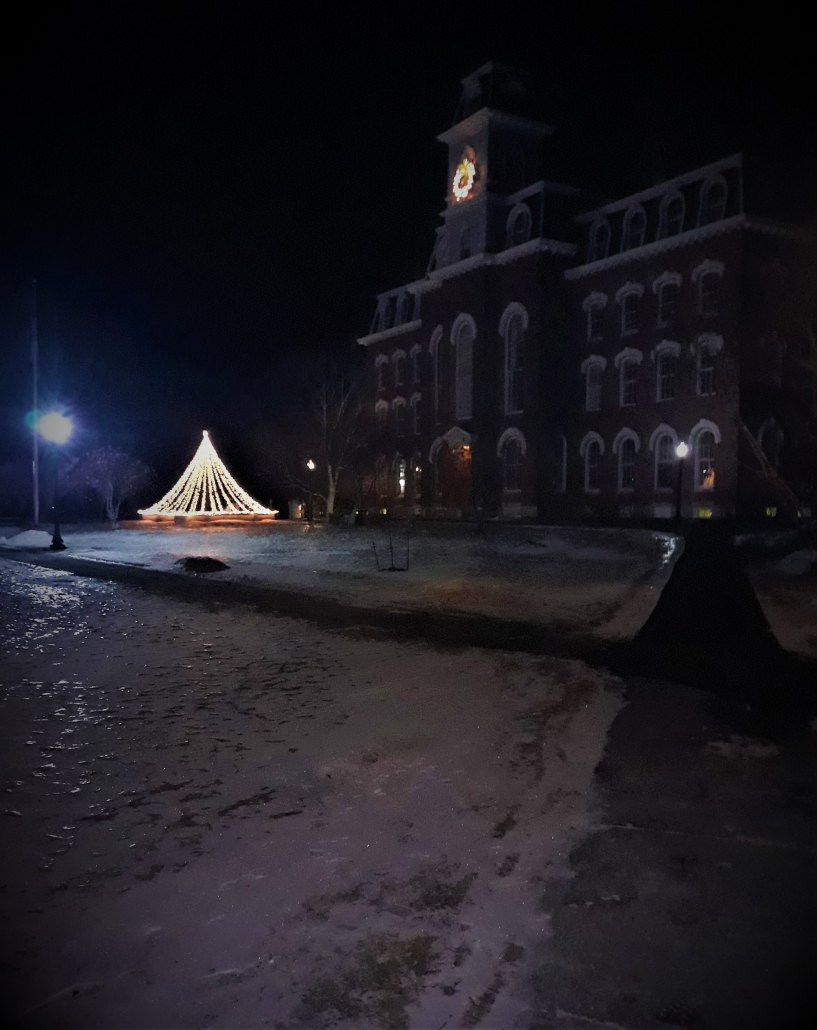
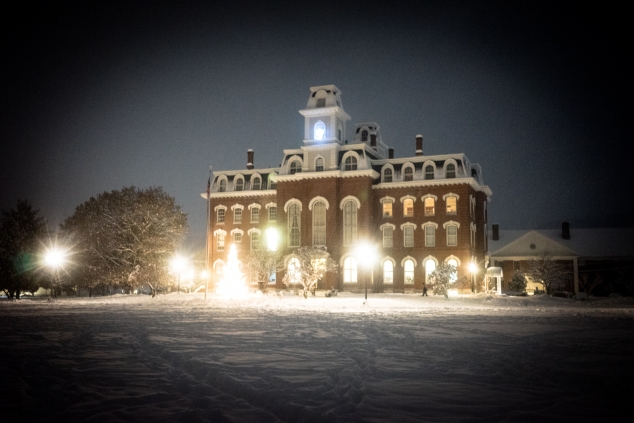
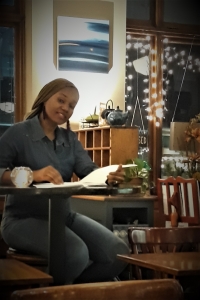 We were all abuzz with excitement to hear Ukamaka read. Her poem “Slut” has just been nominated for a Pushcart Prize. Go Uka! Congratulations! She started off with an intriguing CNF piece about her life in Nigeria, but ended with reading “Slut”. You can view and/or hear it here:
We were all abuzz with excitement to hear Ukamaka read. Her poem “Slut” has just been nominated for a Pushcart Prize. Go Uka! Congratulations! She started off with an intriguing CNF piece about her life in Nigeria, but ended with reading “Slut”. You can view and/or hear it here: 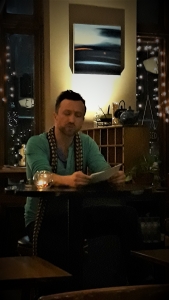 modification pop-up. Part searing, comical send-up, part tender field guide to the underground, his essay brought to mind the weird, wild, wonderful punk-rock art shows of the 80’s mixed with a little Burning Man for good measure. All in our own tiny state capitol, Montpelier.
modification pop-up. Part searing, comical send-up, part tender field guide to the underground, his essay brought to mind the weird, wild, wonderful punk-rock art shows of the 80’s mixed with a little Burning Man for good measure. All in our own tiny state capitol, Montpelier.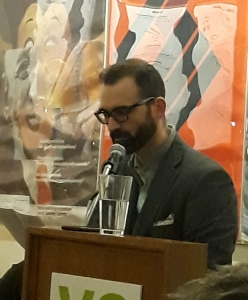 well, beginning with Justin Bigos reading the story of an eight-year-old child going through divorce and homelessness. The piece had an almost vintage, antique feel to it, full of the oddities of a strange museum that the child explores: for example, a piece of wedding cake displayed under glass, a cake that is over one-hundred years old. We then find that it’s more of a contemporary setting when we learn about the father’s love of sci-fi and the child’s blase feelings about Star Wars. There was a really nice tone to the piece, and I look forward to reading it.
well, beginning with Justin Bigos reading the story of an eight-year-old child going through divorce and homelessness. The piece had an almost vintage, antique feel to it, full of the oddities of a strange museum that the child explores: for example, a piece of wedding cake displayed under glass, a cake that is over one-hundred years old. We then find that it’s more of a contemporary setting when we learn about the father’s love of sci-fi and the child’s blase feelings about Star Wars. There was a really nice tone to the piece, and I look forward to reading it.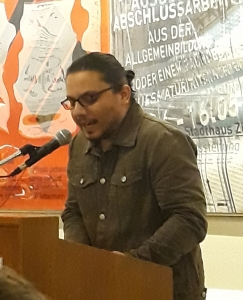 working in the garden section at Home Depot in Florida during the holidays. He commented on the worthlessness of his English Degree, recalling his diploma hung proudly on the wall. Alas, that degree left him to help customers find the biggest, bulkiest, heaviest trees in this store–trees he wished were full of spiders; trees he thought had followed the call of migratory birds who told them that Florida was the place to spend their winters. Hysterical! He followed with a couple more poems that conjured for us his humorous loathing for his home state, and finally, told us a tender and funny story about translating his father’s love poems.
working in the garden section at Home Depot in Florida during the holidays. He commented on the worthlessness of his English Degree, recalling his diploma hung proudly on the wall. Alas, that degree left him to help customers find the biggest, bulkiest, heaviest trees in this store–trees he wished were full of spiders; trees he thought had followed the call of migratory birds who told them that Florida was the place to spend their winters. Hysterical! He followed with a couple more poems that conjured for us his humorous loathing for his home state, and finally, told us a tender and funny story about translating his father’s love poems.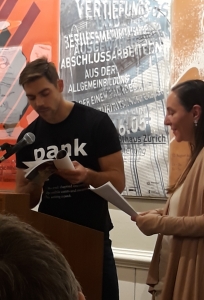 Rounding out the evening were collaborative poets Kristina Marie Darling and Chris Campanioni. They read separately at first, with Kristina regaling us with persona poems about a character named Jane Dark. Jane Dark’s hobby is stealing husbands. The poems are sometimes comical stories about Jane’s resentment of “the other wife.” I hope to never meet someone like Jane, but hearing about her in prose poems was fun.
Rounding out the evening were collaborative poets Kristina Marie Darling and Chris Campanioni. They read separately at first, with Kristina regaling us with persona poems about a character named Jane Dark. Jane Dark’s hobby is stealing husbands. The poems are sometimes comical stories about Jane’s resentment of “the other wife.” I hope to never meet someone like Jane, but hearing about her in prose poems was fun.


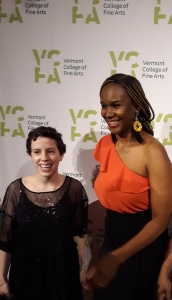

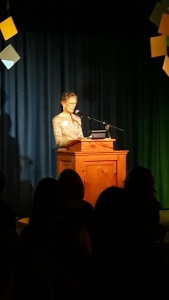 collection Box. Sue is an alum of VCFA’s own MFA in Writing program and lives in Burlington.
collection Box. Sue is an alum of VCFA’s own MFA in Writing program and lives in Burlington.
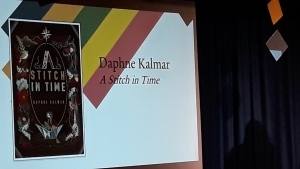 Next came another VCFA Alum, this time from the Writing for Children & Young Adults program. Daphne Kalmar read to us from her debut novel A Stitch in Time. (I have to admit that, when asked which author I wanted the award to go to, Ms. Kalmar was a strong contender, and most of my classmates agreed. Her book cover rocked as well.)
Next came another VCFA Alum, this time from the Writing for Children & Young Adults program. Daphne Kalmar read to us from her debut novel A Stitch in Time. (I have to admit that, when asked which author I wanted the award to go to, Ms. Kalmar was a strong contender, and most of my classmates agreed. Her book cover rocked as well.)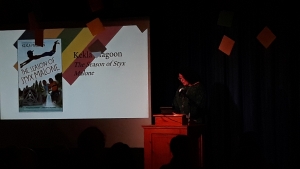 Another Alum, Kekla Magoon (Writing for Children and Young Adults) followed, as did Rebekka Makkai,
Another Alum, Kekla Magoon (Writing for Children and Young Adults) followed, as did Rebekka Makkai, 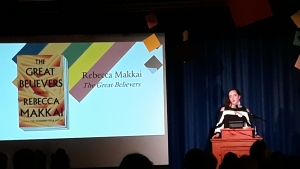
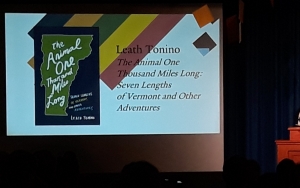 Rounding out the readings were Leath Tonino and Tony Whedon.
Rounding out the readings were Leath Tonino and Tony Whedon.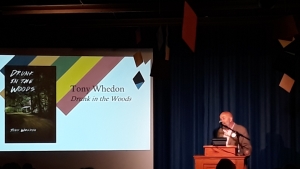

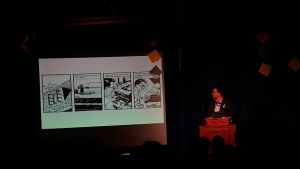 twenty years. A work of historical fiction that describes the fall of the Weimar Republic and rise of facism/Nazism in late 1920’s, early 1930’s Germany, this series of 22 magazines has been complied first into 3 books, and most recently into one complete book. The work has won high praise over the years, being called “one of the great epics of the comics medium,” and landing on Rolling Stones “50 Best Non-Superhero Graphic Novels”.
twenty years. A work of historical fiction that describes the fall of the Weimar Republic and rise of facism/Nazism in late 1920’s, early 1930’s Germany, this series of 22 magazines has been complied first into 3 books, and most recently into one complete book. The work has won high praise over the years, being called “one of the great epics of the comics medium,” and landing on Rolling Stones “50 Best Non-Superhero Graphic Novels”.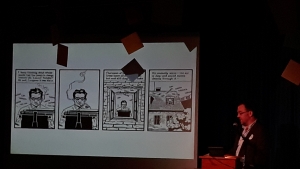

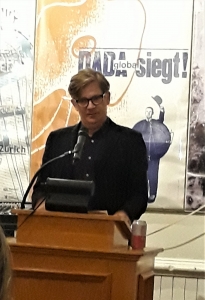 recipient of many awards, including a Pen award for editing. He’s been the judge of many other awards, contests and fellowships.
recipient of many awards, including a Pen award for editing. He’s been the judge of many other awards, contests and fellowships.
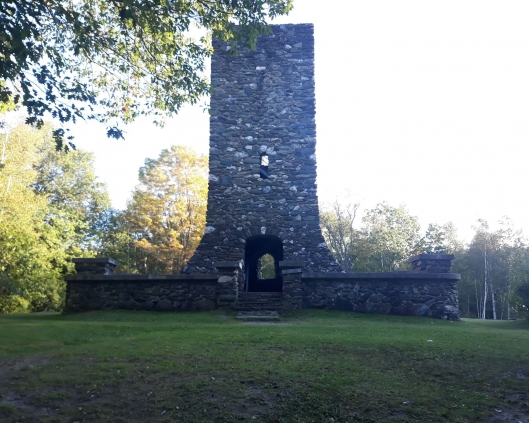
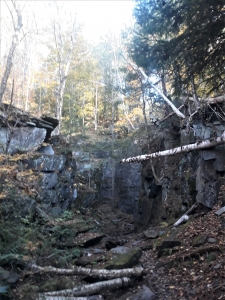 I’ll probably always start these posts with something about the beauty of Vermont, and what a special place
I’ll probably always start these posts with something about the beauty of Vermont, and what a special place  hang on the bottom branches of skeleton forms. Other leaves have just started the jettison process. When people and dogs walk through the fallen leaf-litter they make soft crunching and shooshing sounds, an early reminder of the near-inaudible underfoot crunch of the snow that’s yet to come. The locals tell me that the Fall colors haven’t been as outstanding as in previous years, due to having a drier than normal September, but the leaves have been vibrant enough to make this California girl’s heart go pitter-pat.
hang on the bottom branches of skeleton forms. Other leaves have just started the jettison process. When people and dogs walk through the fallen leaf-litter they make soft crunching and shooshing sounds, an early reminder of the near-inaudible underfoot crunch of the snow that’s yet to come. The locals tell me that the Fall colors haven’t been as outstanding as in previous years, due to having a drier than normal September, but the leaves have been vibrant enough to make this California girl’s heart go pitter-pat.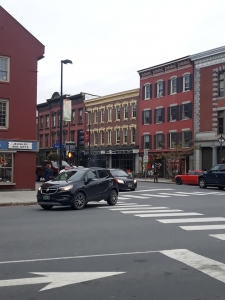 California and Vermont have many similarities: stunning vistas, sophisticated cities with lots of liberal, artsy folks. Cities in Vermont are smaller, of course. Montpelier, for example, is the nation’s smallest state capital, with nearly eight-thousand people. Eight-thousand people would be a town in California, not a city. There’s no doubt, however that Montpelier is a city. It’s downtown area bustles during the day, with locals, those with business at the Statehouse, and tourists.
California and Vermont have many similarities: stunning vistas, sophisticated cities with lots of liberal, artsy folks. Cities in Vermont are smaller, of course. Montpelier, for example, is the nation’s smallest state capital, with nearly eight-thousand people. Eight-thousand people would be a town in California, not a city. There’s no doubt, however that Montpelier is a city. It’s downtown area bustles during the day, with locals, those with business at the Statehouse, and tourists. 
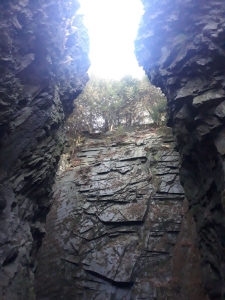 This easy hike begins just steps outside of the back door of the Glover dorms and takes you through a grassy area called
This easy hike begins just steps outside of the back door of the Glover dorms and takes you through a grassy area called 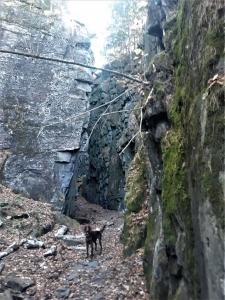 recent tagging it has an ancient or otherworldly feel, with slate walls forming a tall and narrow canyon. It’s quiet and peaceful, and a great place to meditate, or write, or even just sit. It feels as though there’s no one around for a hundred miles, and yet…you can be back downtown in less than a half an hour!
recent tagging it has an ancient or otherworldly feel, with slate walls forming a tall and narrow canyon. It’s quiet and peaceful, and a great place to meditate, or write, or even just sit. It feels as though there’s no one around for a hundred miles, and yet…you can be back downtown in less than a half an hour! There’s also
There’s also 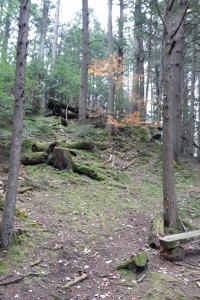 Register of Historic Places.) The park was established in 1899 with the bequeathing of its original 134 acres. The tower sits on land that was deeded to the city in 1911, at the very summit of Capitol Hill. Not only could you see all around the countryside from that summit, the tower stood out like a beacon to those downtown and at the Capitol Building. The hope was that seeing the tower on the hill would draw visitors up to the park.That worked until 1961 when the pines planted on the previously clear-cut pastureland grew tall enough to block the view.
Register of Historic Places.) The park was established in 1899 with the bequeathing of its original 134 acres. The tower sits on land that was deeded to the city in 1911, at the very summit of Capitol Hill. Not only could you see all around the countryside from that summit, the tower stood out like a beacon to those downtown and at the Capitol Building. The hope was that seeing the tower on the hill would draw visitors up to the park.That worked until 1961 when the pines planted on the previously clear-cut pastureland grew tall enough to block the view.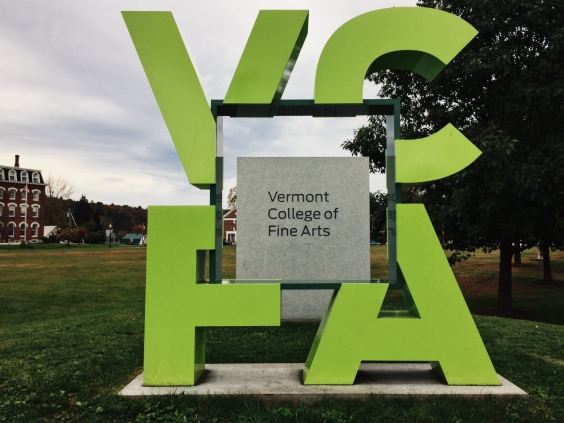
 The leaves have started to change: a spot of scarlet here and there, a clump of crimson among a sea of green. Last week and the week before it was pure green with no red to mark the change. Now, however, the crimson grows with each day while the green, like the sea, recedes. I’m looking forward to the New England color show, as are my fellow out of state students. We come from across the country and across the world, with two from California, two from Oregon (one of them by way of North Carolina), two students from the South (Virginia and Georgia), one from the rust belt state of Pennsylvania, another from Massachusetts, from neighboring counties, and from as far away as Nigeria. We’re a diverse bunch, just getting used to Montpelier, to the dorms and the school, and we are beginning to form friendships with fellow writers that could last for the rest of our lives.
The leaves have started to change: a spot of scarlet here and there, a clump of crimson among a sea of green. Last week and the week before it was pure green with no red to mark the change. Now, however, the crimson grows with each day while the green, like the sea, recedes. I’m looking forward to the New England color show, as are my fellow out of state students. We come from across the country and across the world, with two from California, two from Oregon (one of them by way of North Carolina), two students from the South (Virginia and Georgia), one from the rust belt state of Pennsylvania, another from Massachusetts, from neighboring counties, and from as far away as Nigeria. We’re a diverse bunch, just getting used to Montpelier, to the dorms and the school, and we are beginning to form friendships with fellow writers that could last for the rest of our lives.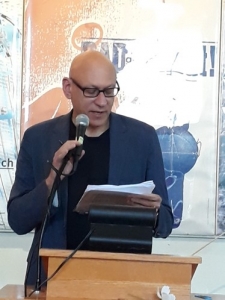
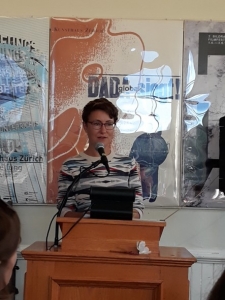
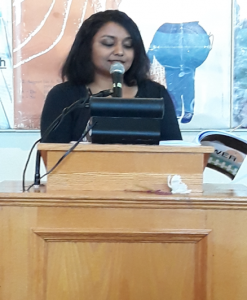 fall on that fateful day. Quite a compelling way to spend the eighteenth anniversary of that event.
fall on that fateful day. Quite a compelling way to spend the eighteenth anniversary of that event.